Something Intangible, Something Shared
December 18, 2016
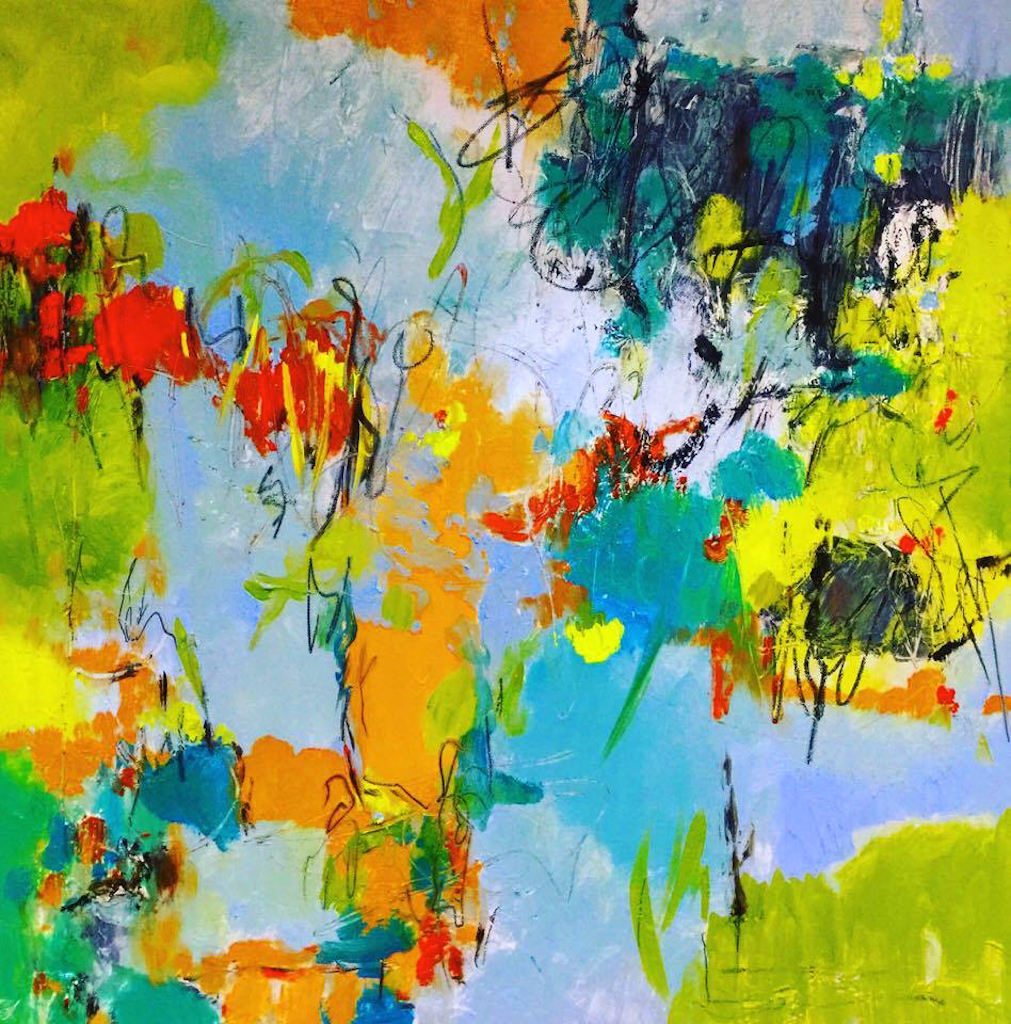
The Vision & Art Project interviews British artist Jenny Oldknow.
This past year, the work of British artist Jen Oldknow underwent a profound shift from representational to abstract, from ink and watercolor to oil and collage, from depicting the outer world to evoking the inner. While macular degeneration is largely behind her changed approach to artmaking, her new style and technique has put her in touch with an exciting new realm of artistic inquiry that builds on her early interest in abstract expressionism. Her new canvases are lush with color, texture, and marks that bid viewers to explore and experience the tracks of intuition and feeling Jen makes manifest.
Born in 1975, Jen was diagnosed with early onset macular degeneration in her twenties, but this didn’t stop her from getting a diploma in drawing and painting at the London Art College and forging a career as a draftsperson and painter who depicted the natural world with great sensitivity. Her eyesight has changed gradually over the years, which has given her time to adjust and adapt her working methods after much soul-searching.
Jen’s recent work has received recognition from the Royal Birmingham Society of Artists, Saatchi Online (www.saatchiart.com/jennyoldknow), and the Stiwdio Maelor Works on Paper competition.
We conducted this interview with Oldknow via email in November 2016.
Interview: Jenny Oldknow
Being diagnosed with vision loss as a young woman
A’Dora Phillips: Perhaps we could first talk about your diagnosis of macular degeneration. When and how did you first learn you had macular degeneration?
Jenny Oldknow: I was 28 when I got the initial diagnosis, in 2004. I was always aware that eye problems were in the family. My maternal grandmother and her twin sister both developed macular degeneration in their thirties, so I knew about the condition and its effects, but I never thought I’d get it, as it has skipped over a generation. My mother and her brother and sisters remain unaffected. I only found out at a routine eye test. I didn’t actually start to really notice the effects on my vision until 2009, five years after initial diagnosis.
Phillips: Were you a working artist when you got the diagnosis?
Oldknow: No. I was making art, and I was an active member of local art societies, but it wasn’t what I considered to be my job. I started painting full time in 2006, a couple of years after I was diagnosed, but when I was still visually unaffected. I guess I was in denial of any future impact at that point! It was the birth of my son, who has severe disabilities, that provided the catalyst for my move into being an artist as a career choice. Life-changing events like having children, especially children who have special needs, often make people rethink how they live, how they earn money, and what is important to them. It certainly did with me.
I have a fear that others will judge my work on another criteria because I am a visually impaired artist
Phillips: How did this diagnosis impact you, emotionally and otherwise—i.e. what did you start thinking about?
Oldknow: I remember doing nothing but crying for the first couple of days, and feeling very sorry for myself. But I’m fortunate in having my grandmother and her sister in my life, as they provided (and still do, in their mid-eighties) a great source of comfort and encouragement that life can still be full and adventurous even when partially sighted. These two ladies are great role models for me, as I see everyday how they’ve raised families, had careers, and retained their independence and done everything they wanted to do, with strength and humor, regardless of their visual problems.
Working with vision loss
Phillips: As an artist with low vision, what are the biggest hurdles you face?
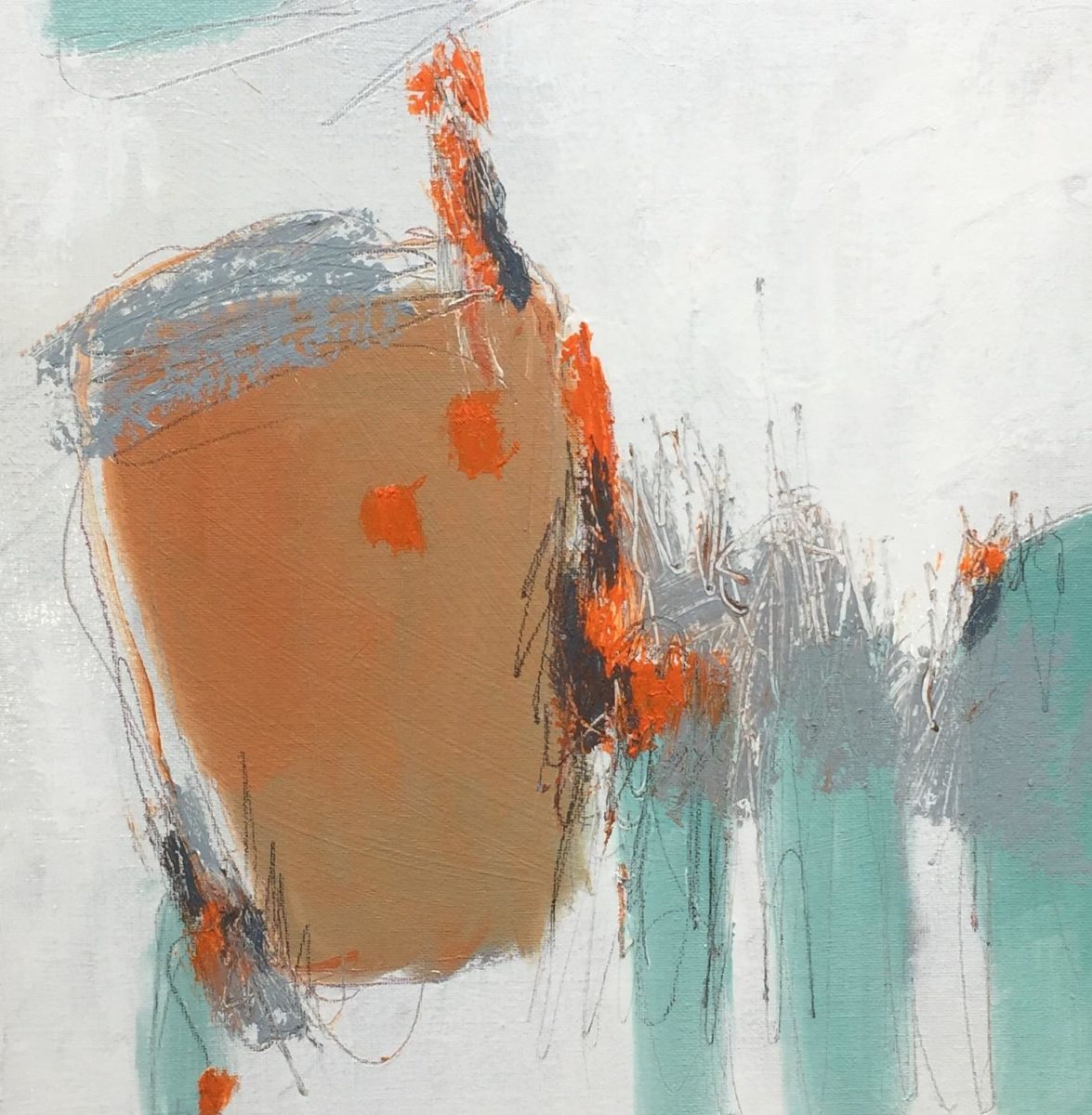
Oldknow: I suppose the obvious things are being able to easily work alone. Things like reading the labels on paint tubes, reading documents and art books, doing computer work, etc.
On another level, I think that I have a fear that others will judge my work on another criteria because I am a visually impaired artist, and I make no secret of that. I think that everything you do as a visually impaired artist could get viewed through a different lens to other artists, because of the sight loss. Perhaps this is something shared by most people with a disability, that they are seen as disabled first, with everything else that they are coming second. The most important thing for me to do to overcome this is to remain authentic in my work.
Phillips: Your recent decline in eyesight has initiated an entirely different direction in your work. Can you describe what you used to see and what you now see?
Oldknow: When my eyes started to be affected, I was mainly working in ink, producing drawings on paper. This process started to become difficult as my vision struggled to see shapes on the paper without some sort of distortion, and lines were becoming an issue. It is like that classic test for macular degeneration, the Amsler grid, where affected people see the wavy lines instead of the straight ones, and occasionally the lines disappear completely because of the blind spots. That was a bit like my drawings! I knew my vision would only get worse, so I began to think about entirely new ways of creating art.
Phillips: You mention that you feel macular degeneration, which could be devastating to a visual artist, only serves to make your work stronger. More clearly focused on your “sources” and “methods of expression.” Can you explain what you mean by “sources” and “methods of expression”?
Oldknow: As I began to explore new directions into abstraction, using oils instead of ink, I began to focus far more on both the process and the materials, rather than the end result, as I had before. How I used to work was a way of simply rendering images of the world around me, animals, trees, etc., but as I started to move into abstraction I began to think a lot more about why I needed to create something.
For a short time I abstracted reality, such as landscapes, but I knew this was not what I wanted to do. Once I had started the journey into abstraction, I realized that my sources of inspiration were shifting from the outside world to the inner world.
It strikes me that as I am losing visual acuity of the physical world around me, I have moved the focus of my art onto the interior world of memory, emotion and feeling—human experiences we all share. I started to write more in a journal, and through the increased writing and thought processes, I could really feel my work becoming far more personal, in terms of what drives me to paint, and the ways I express it, such as color, mark-making, shapes, and composition, etc. I definitely feel I have become a stronger artist because of this. I have more of an individual voice behind the work.
Phillips: Until very recently, you worked mainly in black and white to create drawings and paintings of the natural world. Were these works dependent on direct observation? Does any of this sensibility transfer to your current work?
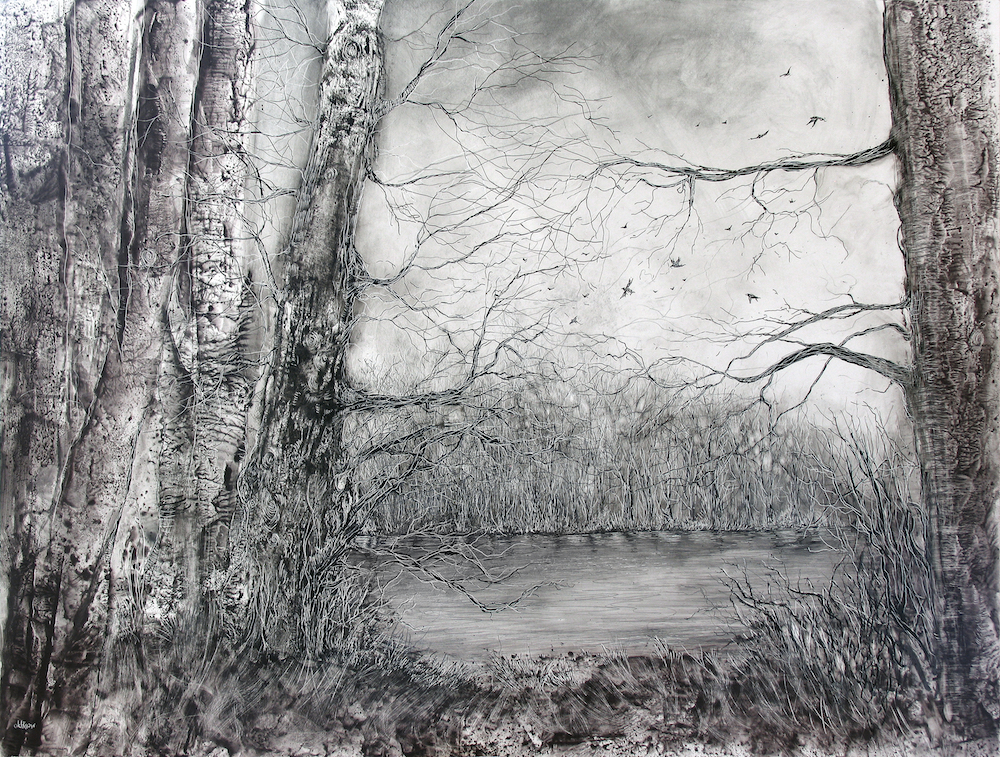
Oldknow: To me, working from direct observation involves using the real world as source material, with the artist experiencing the subject firsthand. When I was working representationally, I depended largely on direct observation. Works were often created from life, or from sketches done on location. My focus was wholly on depicting the real world. In my move to abstraction, I chose to totally reject that way of working.
My recent work comes totally from inside my head, and my soul. If any visual references can be seen that relate to the outside world, they are totally coincidental and without intention.
Memory probably plays a large part, as anything that is not being experienced now is emerging from the memory of what is past, even five minutes ago. What I am trying to do is capture an expression of something, through a language of marks or colors that evoke certain feelings and moods. Instead of showing the viewer a picture of something (such as a tree), my aim is to start a conversation about something, something intangible, but a shared experience such as joy or loss or sadness. By searching deep inside, I want to convey through the medium of paint what I am trying to say, in a way that transcends normal human language of words and facial expressions.
Phillips: Did it take any experimentation or soul-searching for you to move on to this new body of work?
Oldknow: I have periodically played around with doing my own abstract paintings over the years, so I had already done a little bit of experimentation, and knew deep down the way I wanted to take it, but yes, it took a lot of soul searching to make that change.
I think much of it was due to the fact that I was already becoming known for my previous work, so I was worried about how others would judge both my decision to completely change the way I worked, and the work itself. In the end, though, I had to make the decision that was right for me. It is my eyesight that is declining, and my working practice that is being subsequently affected, so I had to do what was right for me. But no, it wasn’t a decision that was made quickly or lightly, without a lot of thought, although it may have seemed that way to onlookers!
Phillips: With the dramatic shift in your work, is there anything you’ve brought with you, so to speak, from the way you used to work?
Oldknow: I can’t put my finger on anything specific that has transferred directly to the creative process of the work I do now. Maybe there are some details, but because I’ve changed my style, tools, and medium so much, they are insignificant. I still love getting out in the countryside, but I do it for the way it invigorates me on a mental and physical level, not with the aim of gathering reference material, like before. It is an essential part of my day to get outside with my dog, and I always feel better in the studio if I’ve been outside first for a walk in the fresh air.
A new studio and working habits and processes
Phillips: You mentioned in a recent email that you were planning to have a new studio by the end of October. Can you tell me about your new studio and what motivated you to build it?
Oldknow: For ten years, I gradually took over the dining room in our home. We ate as a family around the big table in the center of the room, surrounded by easels and shelves containing my tools, and it worked fine. However, when I made the move into oil painting I quickly realized that painting in this medium was not particularly compatible to family life, both because of the inevitable mess and the drying time and because of the larger sizes of my new work.
The idea of moving into a studio started when I read a post on Facebook about some local studios that were being renovated in an old mill. I looked at renting different studios, but we finally decided on converting our garage at home, which has the benefit that when I can no longer drive my working space is literally at my doorstep. We made access to the studio from the aforementioned dining room, so I don’t even have to go outside! It has worked out to be the perfect place, as not only does being at home avoid travel issues, but I can work at unusual hours convenient to me, especially as I have young children. If I want to nip into my studio to varnish a painting or work for 10 minutes at 11pm at night in my PJ’s, I can.
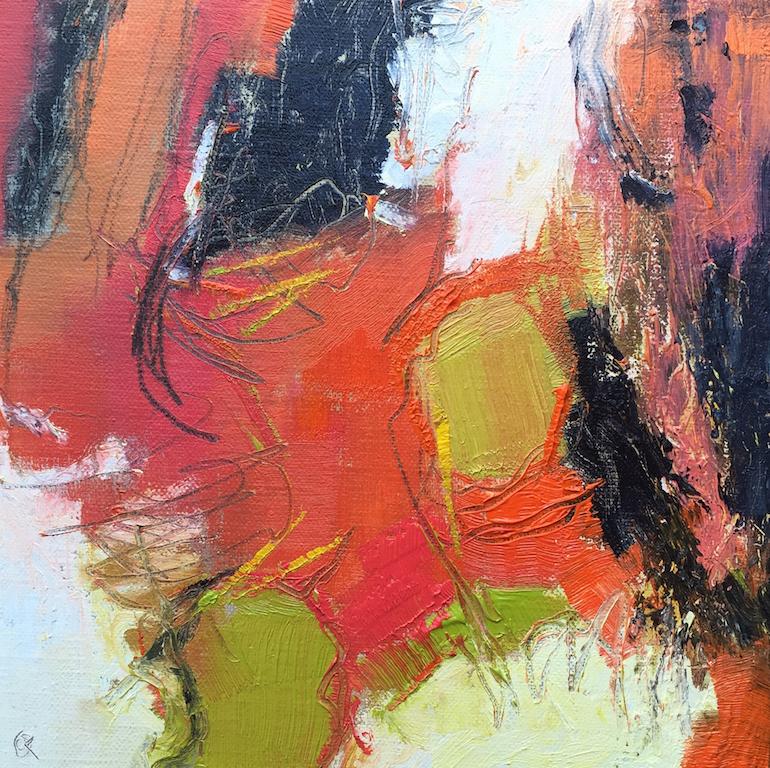
Because I had full control of how it was built, it is perfect for me. It is very light, with white walls and a light wood floor, and lots of really bright lights, which is vital for someone with macular degeneration. It has a new double-glazed window, a radiator, and full insulation, so it’s very cozy in winter.
Everything has been designed and placed around the way I wanted to work. I hang canvases on blocks on the wall to paint, with low shelving all around at about a foot from the floor to hold all the brushes and tools I use, with a wheeled trolley for my paint tubes and palette, so I can easily move it to wherever I am painting. I have a chest of drawers for storage and an easel for works on paper, and that’s about it. I wanted to keep it streamlined and as uncluttered as possible. I love it, as it allows me to leave everything out without having to clear away. It’s a wonderful creative space, within my own home—what more could I ask for?
Phillips: Some of the work you are doing now is smaller scale (approximately 8” x 8”). You’ve mentioned that the limitations of the smaller surface are surprisingly liberating to the creative process. Can you talk about that more, and, in general, your thoughts about art-making and constraints / limitations? (Many artists do find constraint useful, and I wonder if you might have some thoughts as to why.)
Oldknow: Some of my work recently has been around 6 feet, so when I decided to use up a couple of old smaller panels, all under 12 inches, I wondered how that would translate with my new way of working, and was surprised to find that it offered such a liberating experience. I think it’s because of the physicality of it.
The small size means that I can easily start and finish a painting within a single session without a break, which can interrupt the intuitive flow. The fact that the surface is so small means I can see the whole thing easily, all the time, without needing to step back to deliberate my next move, again something that can somewhat break the flow. I can quickly make decisions about what mark to make and where, and what colors to use.
There is also that psychological element of knowing that this is only a small canvas, and is cheaper to produce in terms of material costs, so less is invested in it. I think this frees you up to just go for it and see what happens, an attitude that always has positive effects on the creative process. Less of a battle goes on between my head and the canvas. When faced with a large canvas, which has cost quite a bit of money, it is easy to put expectations on yourself to produce something “special.” With the smaller format, I apply the paint and leave it be, but on the larger canvases it is easy to fall into a habit of fiddling around with it unnecessarily. I can’t speak for other artists, but that is certainly how I experience painting on a smaller scale. In fact, I used up those old panels and ordered more small canvases, some just 6″x 6″, and continued the series Small Treasures, which is still ongoing now.
Phillips: The way you work in oil, you seem to take advantage of its tactile possibilities, and some of the other mediums in which you currently work—most notably collage and oil & wax—are overtly tactile. What is your process of working with these materials?
Oldknow: I simply like to feel like I am part of a physical process of creating the art. Oil allows you to paint with thinned down washes, or thick layers applied with a knife, giving an almost 3D sculptural quality. The slow-drying nature of the paint also gives me extra time to play with the surface, making marks and creating an interesting quality in the work. It is by far my foremost medium.
The collage is a different process to painting entirely, and thus gives a different way of thinking about the work. When I’m painting, it’s all about the emotion in the marks that I’m making, but in collage it’s more of a process-driven approach, where the materials themselves dictate how a piece develops. I wouldn’t go as far as to say that I use touch as my primary sense, as whatever vision remains, what I see on the canvas will always be important to the decisions I make, but it is vital for me to be able to manipulate the materials in the way I want to, so in this I guess it is a tactile experience. In comparison, having tried printmaking in the past, I always felt like the printing process offered a certain detachment from many parts of the creative process, which I didn’t like so much, and wasn’t so satisfying.
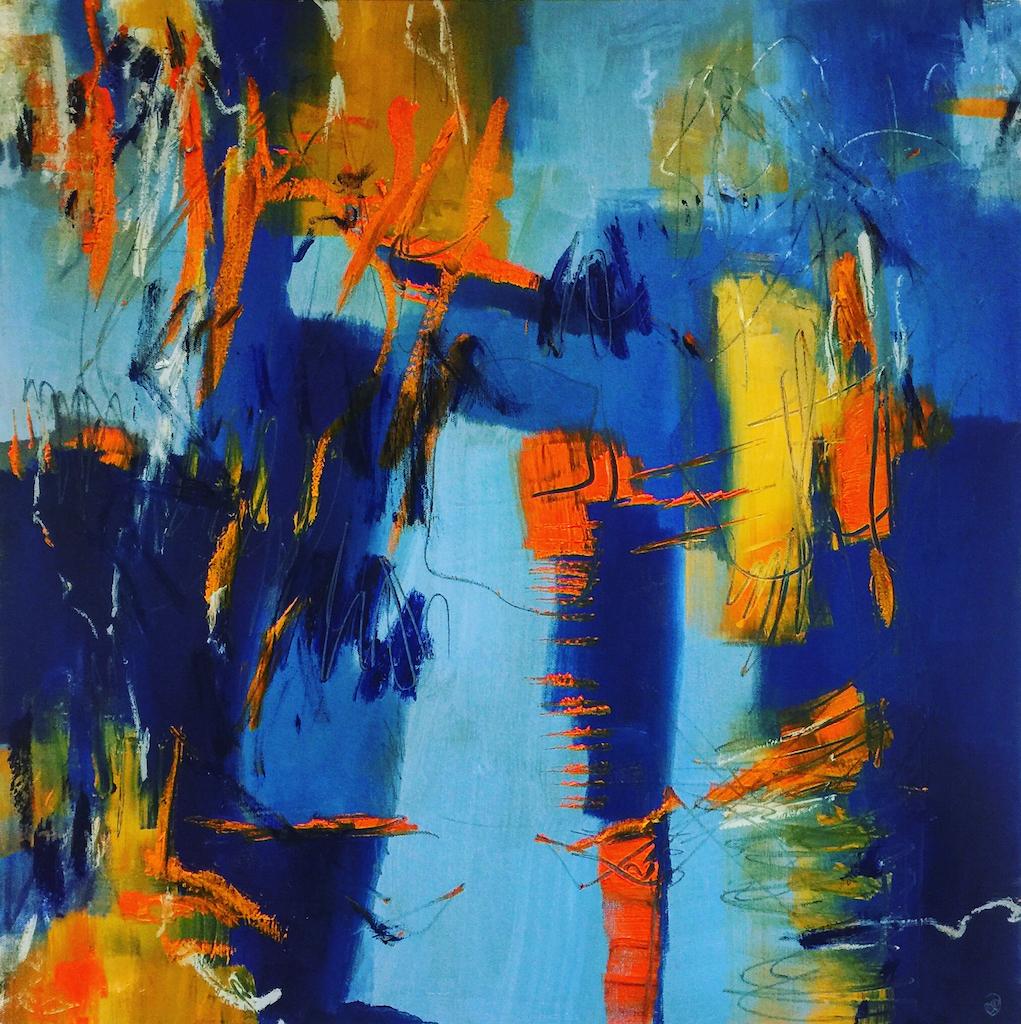
Phillips: So it sounds like sight is as primary to your working method as it has ever been?
Oldknow: I actually think I value the sight abilities I do have even more. I’m trying not to push in any particular direction, but to let the work evolve naturally. My roots as a painter run deep, and I know that staying true to this stands me in good stead. People occasionally ask me if I will turn to something like sculpture when my eyesight deteriorates further, and I don’t think I would. Painting with oils holds the key to the way I want to express myself in ways that no other medium has.
Phillips: Can you talk about your working regimen? I know you have three children. Do you work in your studio every day?
Oldknow: I don’t really have a routine as such, because I have my studio at home I’m in and out all day and evening on most days. It’s certainly not a 9 to 5 thing. What I do is try to paint as often as possible.
I like to get household jobs done first thing, before the children go to school, then I can come back and not be distracted by clearing up the breakfast things and such. I will usually take my dog for a walk straight away too, to wake up my brain in the fresh air, and so I am free to go into the studio and not worry about doing anything else until it’s time to pick up the kids again. It’s a short window of opportunity within school hours. But one of the privileges of what I do is being so flexible with my time and how I use it, so I would hate to start restricting myself with timetables and routine. I’m often back in the studio in the evening, and on weekends.
Like most artists, I juggle painting with the business side of things. I love painting so I just do it as often as possible. I feel I can paint at any time, with no preference for timing, although it is always easier to concentrate fully if I know I have a few uninterrupted hours in front of me. I don’t have any specific warm-up techniques. I just go straight in, as those first few marks on the canvas are usually the most exciting, and set the stage for the rest of the painting.
Titles and the influence of language in Oldknow’s artwork
Phillips: The titles of your larger paintings are extremely evocative. How do you come up with your titles? Are they ever the starting place for one of your paintings?
Oldknow: The title often comes during the painting process, but the intention is dictated right from the start. By that I mean I don’t start painting a happy painting in a joyful mood, then call it something very melancholic the next day. Before I pick up my tools and choose the colors, there are words in my head that ignite the painting and drive it forward to its conclusion. I keep hold of these words and this mood as I paint the piece, which is when the title often comes into play. Sometimes these words have been formally composed beforehand, such as in my visual poetry series, so it is even clearer what words are being examined as I paint.
My journal and the words it contains are the most important thing to my painting process, and help drive out any preconceived images of the painting. If I imagine the painting beforehand it makes it more of a prescriptive process as I try and recreate the image in my head. If I have no image in my head to start with, the creative process can be more intuitive, less planned and contrived.
Phillips: You also now have a series of visual poetry on your site, in which you respond through painting to your own words. Is writing—and the combination of writing and painting—a new direction for you?
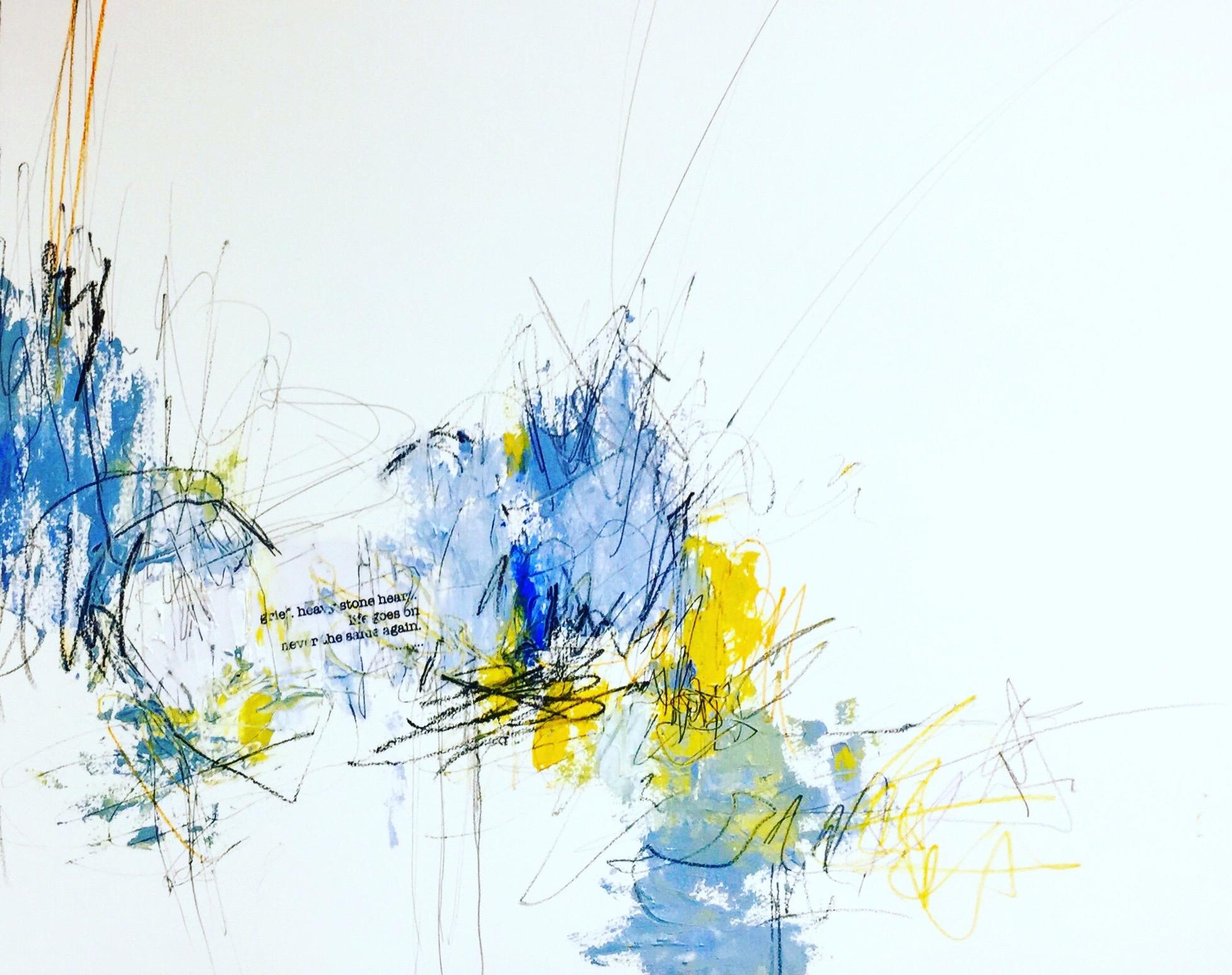
Oldknow: I have always written what I call poetry, and by this I do not want to imply that I consider myself a poet in any way, nor do I wish to produce writing that is in the correct convention of poetry. The relatively unedited words I write are not intended as stand-alone works of art, but are the starting and end point of my painting process. At first I kept this link between the words and the image to myself, but found that many people liked to see the link, so I started to put them out there. The words are intrinsically linked to the painting, and could not exist without each other, so to me they are a complete work, to be considered as a whole.
Phillips: In the writings, you cite feelings of grief and fear, as well as what I interpret as faith in the healing power of art. Can you talk a bit more about the feeling source of these poems and images?
Oldknow: The words I write are taken directly from my own life, my own experiences, and the feelings and emotions that result. Although these may be ideas that many people share and can relate to, they are interpreted from my personal viewpoint. Yes, I do have faith, both in God and in the healing power that creating something has on people. It has certainly healed and continues to heal me. The words I write and the images I paint are an outpouring of what is inside me, my way of expressing what I want to say. Words take me so far, and then the paint takes over in a way that transcends language. Honest expression is good, and allows everything that is kept bottled up to be explored and to some extent, validated.
Phillips: Is the poem that begins “has it taken the darkening?” a specific reference to your macular degeneration?
Oldknow: Yes, these words are directly referring to my vision loss.
Phillips: You mention on your website that “words breathe life into the marks made.” Can you elaborate on this?
Oldknow: The words come before the painting, at least a few of them. Sometimes more come during the painting process. It is so hard to verbalize how the words affect the painting, but I think it’s that sometimes overused word intuition that leads it all. As I feel and think those words, which initiated deep inside me, the marks I make, the colors I use, and the shapes that emerge on the canvas reflect something of those words. My meaning and intent show in the paint surface. It is a personal process that cannot be easily interpreted nor verbalized. I guess if I could explain this fully, there would be no need to paint it out. The paint finishes what the words start. The painting wouldn’t happen without those words in my head, so it is inevitable for me that the words give life to the painting.
Phillips: How has your use of a sketchbook evolved over the course of your career?
Oldknow: It was always instilled in me that keeping a regular sketchbook is a vital part of an artist’s daily practice, and indeed when I was working representationally, I would always sketch the world around me, both for practice and for capturing possible subjects. Now that my work has moved away from portraying reality, I no longer feel that need to draw what is around me. I look inside for what is motivating me to paint at that moment in time, and I feel it is the regular act of writing in a journal that is filling the gap that a sketchbook may have left.
By putting my feelings and thoughts onto the pages of my notebook I can channel my emotions more effectively, and transfer their focus into the practice of painting. I have found that putting those marks into a sketchbook first, by way of recording or exploring, has only acted to distill my process. I prefer to outpour those emotions onto the canvas right from the start and I don’t want to lose any of that spontaneity on the pages of a sketchbook, so keeping one has become less important to my practice. I do have a sketchbook for small collage studies, researching things like color, etc, but I don’t specifically refer to it when painting. It is a place that is an ideal way to create if I don’t have time to paint.
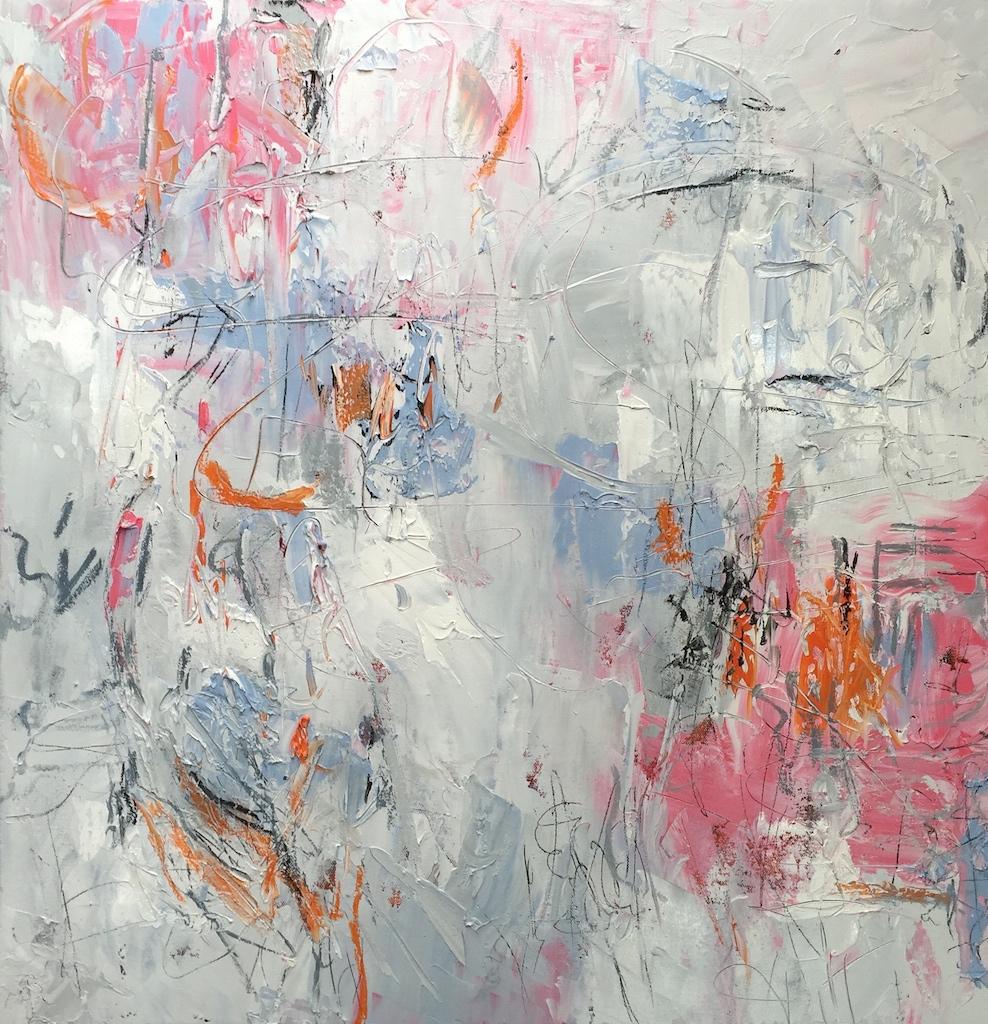
Phillips: You say on your website that you continually ask questions of both yourself and the materials you use, in response to issues that cannot necessarily be seen, yet are shared by all. The aim is not to offer an explicit answer, but to entice the viewer into a conversation. Are you able to put into words what questions and issues you’re exploring in your work? Or is this a purely visual experience for you?
Oldknow: The visual experience is unmistakably there, as it is a painting that I am creating. A visual piece where the process of painting it is as important as the end result. For me, the painting source, inspiration, whatever you want to call it, that motivating thing that moves me to pick up a brush, has to come from inside me. It has to come from my own experience of feeling something firsthand. The whole process is a mix of thinking and trying not to think too much, and letting the paint instinctively make the marks my hand wants to make. It’s all about having a conversation with the materials as I work.
None of the issues I am painting about have definitive answers, so I am certainly not trying to come to any conclusions through the work. Because these are emotional, rather than physical experiences, there is no recognized imagery. The whole concept hinges on me being authentic and honest throughout the process, placing marks on the canvas, and responding to them with further marks until I feel and know that the painting is “finished.” By “finished” I mean that it says what I want to say. The hope is that if people choose to look at my work with an open mind, they will see both what I am trying to say, and imprint their interpretation on it, continuing the conversation that I started within the walls of my studio.
Artistic training and influences
Phillips: Can you tell me a little about your early desire to be an artist and your training?
Oldknow: I have always loved art, and excelled in it at school, but it was never on my radar to be a professional artist when I grew up. My aunt is an artist, both my mother and father talented painters, so I always saw people create. It was natural to do it myself. It wasn’t until after I gave birth to my first son that I started to paint more.
The intention was for me to go back to work after maternity leave, but our son was born with severe health and learning disabilities, and I found I was attending to so many specialists it was impossible for me to go back to work, and I wanted to stay at home with him. Due to epilepsy medication, he had lengthy naps so I just started to paint more often as I loved it and it helped me relax. People told me to try to sell my work, and when a new gallery opened in my town I approached them. They took my work and it sold and that was it, really. Art provided a release for me emotionally, and it gave me the perfect flexibility I needed to look after my children, as it continues to do today.
I completed a diploma in drawing and painting through home study. I have undertaken several workshops with respected practicing artists, which have been a great learning experience. Now that my children are a little older, I am considering options for further study.
Phillips: Are there any artists that have been particularly important to you in the development of your work?
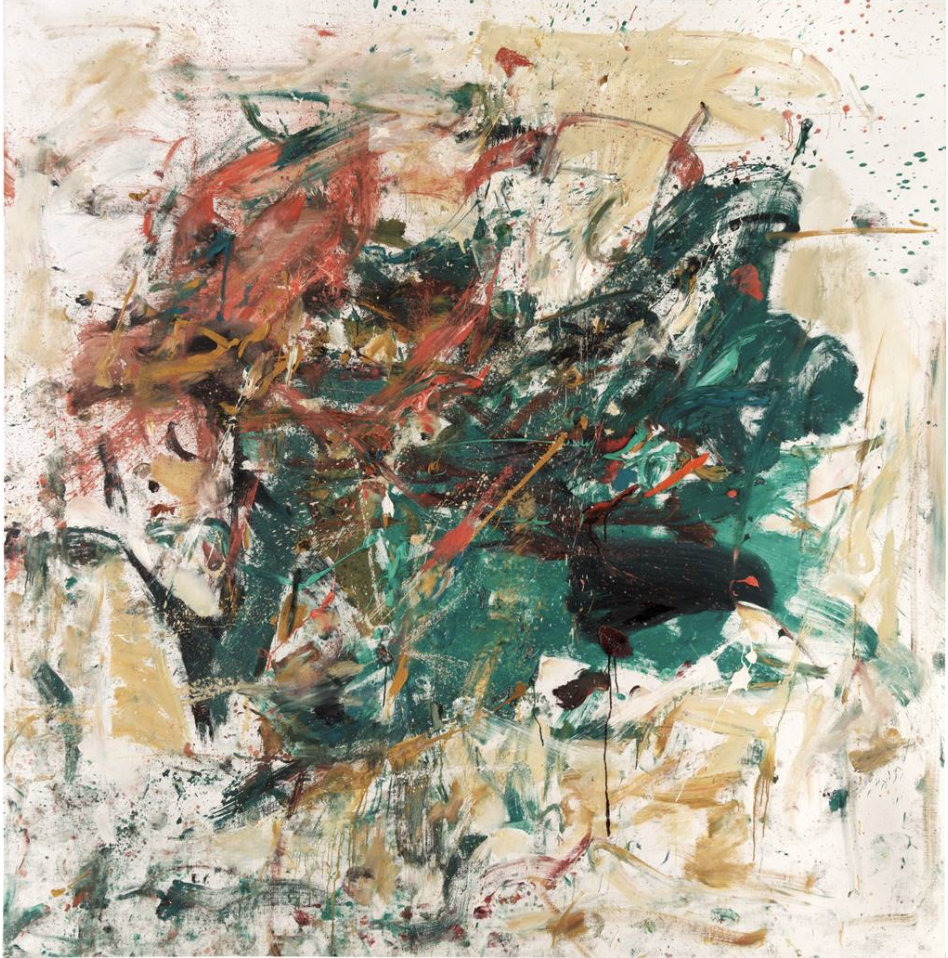
Oldknow: As a genre, the abstract expressionists of the mid-20th century are probably the artists I connect most to in regards to my work. As a woman, the female artists of that time are of interest to me, a particular favorite being Joan Mitchell.
Since I started to paint professionally, one British artist has always been an inspiration, and that is Shirley Trevena. Not so much for my work, but for the way she has always done her own thing, and the way her personality comes across in her work and she has always stayed true to herself. There are lots of contemporary artists whose work I find interesting. American artist Jenny Nelson, and British artist Rose Hilton, both of whom produce work that is so consistently strong. Two British artists stand out for me in terms of coping with vision loss: Joanna Brendon, who experienced vision loss for a time, and Sargy Mann, who continued to painted after he went totally blind. They are a big inspiration.
Phillips: You mention attending the recent abstract expressionist show in London. What are some of the things that most impressed you about it?
Oldknow: It was a wonderful show, at the Royal Academy. It’s hard not to be overwhelmed by all those huge paintings by these iconic names. Many of those images are so well known. It’s hard not just to stand there in awe, which of course I did, but I pushed myself past that and spent time with the paintings, just absorbing the whole and then getting as close as the security would let me! It was fascinating seeing the marks they made close up, which is something you only see in person.
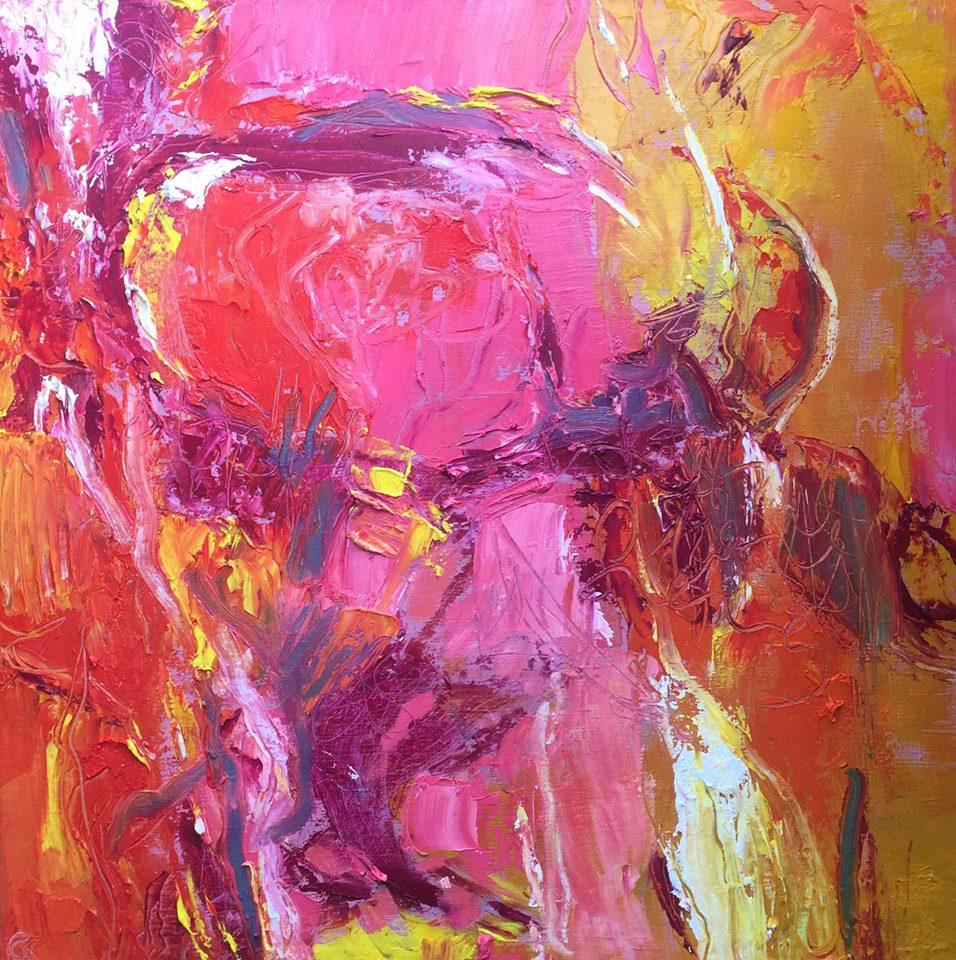
I think what impressed me was realizing how dynamic these paintings are today, so they must have been revolutionary back in the mid-20th century. What also struck me is that each artist developed their own voice, producing some very different works under the umbrella of “abstract expressionism,” a name that I don’t think they themselves would choose.
It made me think that there was still room today for contemporary painters, including myself, to continue the dialogue and to carry on expressions of the inner landscape through the medium of paint. I combined the exhibition visit with attending a talk with Christopher Le Brun, who is president of the Royal Academy and Tim Marlow, artistic director at the Royal Academy, together with several members, some of whom had personally known the artists featured in the exhibition, so offered fascinating insights, and an overview of the exhibition from perspectives I would never have thought of.
Phillips: What most inspires you to work every day?
Oldknow: An overwhelming drive to create something. The drive to create has only intensified with the growing confidence I have gained in my work. As my direction has become clear, and my focus honed, it has become even more important to me to be able to express myself through paint. My job is to show up in the studio, with my tools and paint, and face the blank canvas with honesty and integrity. Sometimes paintings emerge relatively easily; others come with a struggle from start to finish as I grapple with what I am trying to say. There is no pattern, and each painting is a journey into the unknown as I return to the studio each day to create the next painting.
Every day that I am alive brings new experiences I can place on the canvas, so I see my journey in creating art mirroring my life, and transitioning as I do. I can’t imagine stopping painting, so that’s what inspires me to work each day.

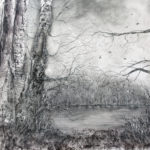
Leave a Comment